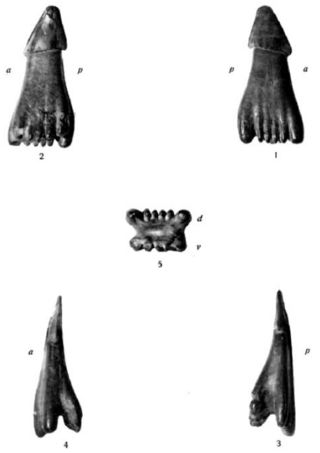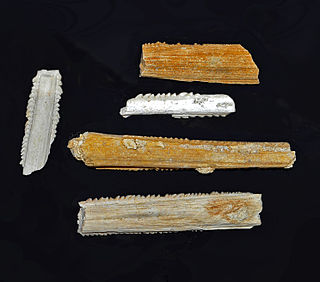Related Research Articles

Squalicorax, commonly known as the crow shark, is a genus of extinct lamniform shark known to have lived during the Cretaceous period. The genus had a global distribution in the Late Cretaceous epoch. Multiple species within this genus are considered to be wastebasket taxon due to morphological similarities in the teeth.

Carcharias is a genus of mackerel sharks belonging to the family Odontaspididae. Once bearing many prehistoric species, all have gone extinct with the exception of the critically endangered sand tiger shark.
Congorhynchus is a genus of prehistoric ray-finned fish that was described by E. Darteville and E. Casier in 1949.

Gasteroclupea is a genus of prehistoric clupeiform fish that is related to modern anchovies and herrings. Its fossils date back to the Maastrichtian stage of the Late Cretaceous period. Fossils of the genus have been found in the Yacoraite Formation of Argentina and the El Molino Formation of Bolivia.
Coriops is a genus of prehistoric bony fish. Its fossils are found in Campanian, Maastrichtian, and possibly Paleocene age deposits. This chronological distribution means that the genus may have survived the Cretaceous–Paleogene extinction event that killed the dinosaurs.
Eodiaphyodus is a genus of Elopiformes fish that is classified in the suborder Albuloidea. It is related to the modern Tarpon. This fish lived in what is now Morocco during the Late Cretaceous Period. It crushed its food with bony plates found in the back of its throat.
Ctenopristis is a prehistoric genus of sawfish whose fossils are found in rocks dating from the Maastrichtian stage in Jordan. The anterior teeth of Ctenopristis have a high cusp compared to certain other ancient sawfish genera.

Dalpiazia is an extinct genus of sclerorhynchid sawfish whose fossils are found in rocks dating from the Maastrichtian stage in mines in Jordan, Libya, Morocco and Syria. The type species D. stromeri was named by Checchia-Rispoli (1933) in honor of Ernst Stromer, and the holotype, a rostral tooth, was found in Tripolitania, Libya.
Igdabatis is a prehistoric genus of ray whose fossils are found in rocks dating from the Maastrichtian stage of Spain, the Dukamaje Formation of Niger and the Takli, Lameta, Fatehgarh and Intertrappean Beds Formations of India.
Pucabatis is a prehistoric genus of ray whose fossils are found in rocks dating from the Maastrichtian stage. The type and only species is P. hoffstetteri. Fossils of Pucabatis have been found in the El Molino Formation of Bolivia and the Bagua Formation of Peru.

Pucapristis is a prehistoric genus of sclerorhynchid ray whose fossils first appear in the fossil record in rocks dating from the Maastrichtian stage. The genus was described in 1963 by Schaeffer. Fossils of Pucapristis have not been found in any subsequent strata. Incidentally, the Maastrichtian is the final portion of the Cretaceous Period and its endpoint marks the advent of the Cretaceous–Paleogene extinction event. This major geological transition is famous for being the mass extinction that wiped out the dinosaurs.

Rhombodus is a prehistoric genus of ray belonging to the family Rhombodontidae.
Erquitaia is a poorly known genus of prehistoric galeomorph shark whose fossils are found in rocks dating from the Maastrichtian stage.
Phyllodus is an extinct genus of bony fish from the Maastrichtian to Middle Miocene. Fossils of the genus have been found in the Maastrichtian to Lancian Hell Creek Formation and the Eocene London Clay.
Anomoeodus is an extinct genus of prehistoric ray-finned fish belonging to the family Pycnodontidae. This genus lived during the Late Cretaceous period, ranging from the Albian to Maastrichtian ages, and had a wide geographic distribution, with fossils found in France, Belgium, the Netherlands, Spain, Egypt, Uzbekistan, and the United States. The first fossils of Anomoeodus were described by Louis Agassiz in 1835.
Socognathus is a genus of prehistoric chamopsiid polyglyphanodontian lizards containing species that lived from the Middle Campanian stage to the late Maastrichtian. Several specimens of the type species, Socognathus unicuspis, have been found in Alberta, Canada. A second species, Socognathus brachyodon is known from the late Maastrichtian Lance Formation; its fossils have been found in Wyoming, United States.

Serratolamna is an extinct genus of mackerel sharks that is placed in the monotypic family Serratolamnidae.
Galagadon is an extinct genus of small carpet shark that lived during the Late Cretaceous period. It contains one species, G.nordquistae. It was named after the video game Galaga due to a resemblance between its teeth and the spaceships in the game, and Field Museum volunteer Karen Nordquist.
Tomewingia is an extinct genus of rajiform ray from the Maastrichtian epoch of the Cretaceous period. It is known solely from isolated teeth from a single species, T. problematica. The genus is named for Thomas Ewing. The species was first described from the late Maastrichtian Kemp Clay Formation of Hunt County, Texas, but has since been found in Maastrichtian strata in the Arkadelphia Formation of Hot Spring County, Arkansas, the Severn Formation of Prince George's County, Maryland, and Fairpoint Member of the Fox Hills Formation in Meade County, South Dakota. This genus was originally named Ewingia; however, this name was found to be preoccupied by a mite found in the gills of certain land crabs. This rendered the name a junior homonym.
Kookne is a prehistoric bird genus from the Late Cretaceous. Known from a coracoid, the remains of the only known species Kookne yeutensis were found in rocks from the Late Cretaceous (Maastrichtian) Chorrillo Formation of Santa Cruz, Argentina.